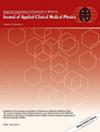Evaluating dosimetric parameters with a plastic scintillator for megavoltage photon beam quality assurance
Abstract
Introduction
Linear accelerators require a large amount of data to be collected daily, monthly and annually to verify safe deliveries for patients. Different detectors have been utilized to improve the simplicity, efficiency and accuracy of the various experimental setups required to collect the necessary data resulting in reduced data collection and evaluation time. Plastic scintillators are stable and energy independent radiation detectors with high spatial resolution that emit light proportional to the amount of radiation incident on them. With an appropriate photodetector and technique to measure and analyze the light that is emitted, scintillators can be utilized to measure dosimetric parameters necessary for various monthly quality assurance requirements.
Methods
A uniform cylindrical plastic scintillator imaged by a complementary metal oxide semiconductor (CMOS) camera is designed to act as a radiation detector to measure 2D projections of linear accelerator beams. Beams were delivered to the detector to evaluate machine quality assurance (QA) parameters, including beam energy, output, profile consistency and reproducibility as described by TG-198. These measurements were compared to calculations from the Eclipse treatment planning system (TPS). Typical monthly quality assurance (QA) beams were delivered and 2D projections of the scintillation light were measured to validate the accuracy and reproducibility of this detector system for monthly QA.
Results
The plastic scintillator was able to accurately characterize the radiation beam. Energy and profile measurements were reproducible and within 2%/2mm of calculations in the TPS. Output measurements had maximum variations of up to 1.3% and average differences of 0.5%.
Conclusion
A simple cylindrical plastic scintillator and CMOS camera radiation detector setup was designed and tested for measuring monthly QA dosimetric parameters specified by TG-198 with accurate and reproducible output, energy and profiles measurements. This method reduces the number of measurements required, allowing multiple parameters to be evaluated in a single beam delivery.


 求助内容:
求助内容: 应助结果提醒方式:
应助结果提醒方式:


